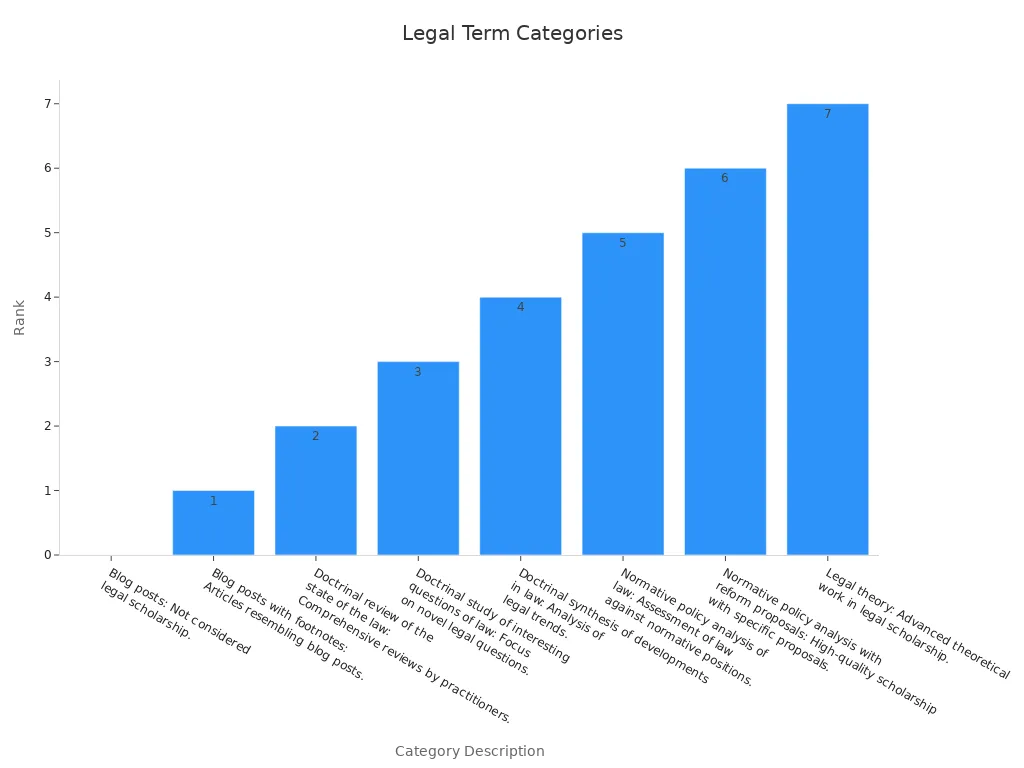Inside the World of Legal Writing: Term of Art Revealed

In legal writing, "terms of art" are special phrases. These phrases have exact meanings for legal accuracy. For example, "beyond a reasonable doubt" has a specific legal meaning. You cannot replace it with simpler words. These terms prevent confusion and keep ideas clear. Research shows organized lists in legal writing help understanding. They are 30% easier to remember. By mixing accuracy with clarity, legal writing can be clear. It can also stay professional and easy to read.
Key Takeaways
Terms of art are special words with exact meanings in law. They stop confusion and make writing clear.
Legal dictionaries help you learn terms of art and their meanings in law.
Being clear and consistent in legal writing is very important. Terms of art give lawyers a common way to communicate.
Clear legal writing builds trust with clients. It helps them know their rights and avoids confusion.
Editing is important. Fix grammar, structure, and clarity to make writing better.
Use simple words when you can. This makes legal writing easier to understand but still correct.
Context is important in legal writing. Words can mean different things depending on the situation.
Ask legal experts for advice. Their ideas can help you improve your writing and arguments.
Understanding Terms of Art in Legal Writing

What Are Terms of Art?
Terms of art are special words or phrases with exact meanings. They are used in specific fields, especially in law. These terms cannot be swapped with everyday words. They explain ideas that are unique to their field. For example, "due process" means fair treatment under the law. You cannot use simpler words to explain it without losing its meaning.
Legal writers often use terms of art. These are technical words or phrases tied to a profession. Some come from law, while others come from fields like medicine or engineering.
To learn these terms, you can use legal dictionaries. These books explain the words found in legal texts. They also help show how terms of art work in legal writing.
Legal dictionaries help readers understand words in legal documents.
They explain legal ideas clearly and highlight important terms of art.
The meaning of a term of art depends on its legal use. If a law defines the term, that definition is the most important. This keeps the meaning clear and avoids mistakes.
If a law or code defines a word, that definition is used. Federal laws often list definitions in a special section.
Characteristics of Terms of Art
Terms of art have unique traits that make them different from regular words. These traits help them work well in legal writing:
Precision: Each term has a clear meaning with no confusion.
Consistency: Legal experts use these terms the same way in all documents.
Context-dependence: A term’s meaning depends on where it is used in law.
The table below shows types of legal words and examples:
Type of Terminology | Description | Examples |
|---|---|---|
Specialized terminology | Words made for legal use to explain specific ideas. | affidavit, tort, writ, litigation, motion, damages, assume |
Foreign terminology | Legal words from other languages, like Latin or French. | en banc, habeas corpus, in camera |
Archaic terminology | Old words still used in law to avoid repeating ideas. | heretofore, thereupon, whereabouts |
These traits make terms of art important for legal experts. They keep legal writing clear and accurate, even for hard topics.
Examples of Terms of Art in Legal Contexts
You can find terms of art in many legal papers, like contracts or court decisions. Here are some examples:
Beyond a reasonable doubt: This phrase shows the proof needed in criminal cases.
Consideration: In contracts, this means something valuable shared between parties.
Habeas corpus: A Latin phrase meaning "you shall have the body," used to fight illegal detention.
Each term has a specific meaning that cannot be replaced with simple words. For example, "consideration" in contracts is not just "thoughtfulness." It is a legal rule for valid agreements. Also, "habeas corpus" has no plain English match because it explains a unique legal idea.
Using terms of art makes legal writing clear and professional. But you should think about your audience. Legal experts know these terms, but others might need extra explanations or definitions.
The Importance of Terms of Art in Legal Writing
Ensuring Precision and Consistency
Terms of art are key for clear legal writing. These special phrases explain legal ideas without confusion. For example, "preponderance of the evidence" and "probable cause" have exact meanings. But studies show judges sometimes understand these terms differently. One study found judges rated "preponderance of the evidence" as 54.4% and "probable cause" as 49.7%. This shows why using clear terms is important to avoid mistakes. It also helps ensure fairness in legal cases.
Using terms of art lowers the chance of misunderstanding. These phrases create a shared language for legal experts. This helps everyone understand the same idea the same way. Consistency like this keeps legal documents and decisions accurate.
Helping Legal Professionals Communicate
Clear language is important for legal communication. Using terms of art correctly helps judges, lawyers, and clients understand tough legal ideas. Legal writing is often how professionals share information. Whether writing contracts or court opinions, clear writing shows skill and professionalism.
Confusing language in legal papers can cause problems. For example, unclear contracts might let one person take advantage of another. Using precise terms of art stops this and builds trust. Clients feel safer when they know their rights. This trust improves your reputation as a lawyer.
Good legal writing also helps teamwork. When everyone uses the same words, it’s easier to talk about cases and share ideas. This shared understanding makes the legal system work better.
Preventing Misunderstanding of Legal Ideas
Misunderstanding legal ideas can cause big problems. Imagine a contract with unclear terms leading to a fight. This could mean expensive lawsuits or unfair results. Terms of art reduce these risks. These phrases have exact meanings, so there’s less chance of error.
For instance, "consideration" in contracts means something valuable shared between people. If you replace it with "payment," the meaning changes. This could confuse whether the contract is valid. Using the right terms keeps your writing correct and legally strong.
Precise words also help explain arguments clearly. Judges need clear writing to make good decisions. Using terms of art shows your knowledge and supports fair legal processes.
Balancing Clarity and Technical Accuracy in Legal Writing

Strategies for Defining Terms of Art
Explaining terms of art helps readers understand their exact meaning. First, find words that might confuse your audience. Define them clearly in the text or as notes. For example, "consideration" in contracts means "something valuable shared to make an agreement." This method explains the term without making it too complicated.
Using examples can also make hard ideas easier. For instance, think of "due process" as a fair game with equal rules. This makes legal ideas feel more familiar. Editing your work carefully is also important. After writing, take a break before reviewing it again. Focus on fixing grammar, clarity, and structure. This helps improve your writing.
Description | |
|---|---|
Use Active Voice | Active voice makes sentences easier to understand. |
Be Concise | Keep writing short and clear; avoid repeating ideas. |
Avoid Legalese | Simple words explain tough ideas without losing accuracy. |
Focus on Editing and Revision | Careful editing makes your writing clearer and better organized. |
Using Plain Language Without Losing Precision
Plain language makes legal writing easier to read. Complicated legal words can confuse people. Use simpler words to make your writing more inclusive. For example, replace "heretofore" with "until now." This keeps the meaning but makes it easier to understand.
Clear writing also forces you to explain ideas directly. You can't use vague or confusing phrases. Instead, you must say exactly who does what. This reduces mistakes and helps people understand better. Studies show plain language makes documents stronger and builds trust. Trust is very important in legal communication.
Complicated words can lead to mistakes and confusion. Clear writing shows exactly what is happening. It helps people understand and builds trust. Plain language makes legal writing more persuasive and easier to follow.
Avoiding Overuse of Legal Jargon
Legal jargon is useful but too much can confuse readers. People who don’t know legal terms may find your writing hard to follow. To fix this, use jargon only when needed and explain it. For example, "habeas corpus" means "a legal action to fight illegal detention."
Simpler words can replace overly complex ones. For example, instead of "subsequent to," use "after." This makes your writing clearer without changing the meaning. The goal is to share ideas clearly, not to impress with fancy words.
Legal writers should make their writing clear while using specific terms.
Too much jargon or complex language can confuse readers.
Using simpler words while staying accurate is a good practice.
By mixing clarity with accuracy, legal writing can be professional and easy to understand.
Categories of Legal Words
Special Legal Words
Special legal words explain tricky ideas in simple ways. For example, an "affidavit" is a written promise made under oath. "Litigation" means taking a problem to court. These words help lawyers talk clearly and avoid confusion.
Legal experts group these words by how they are used. The table below shows these groups, ranked by importance:
Rank | Type of Writing Description |
|---|---|
0 | Blog posts: Not seen as serious legal writing. |
1 | Blog posts with notes: Blog-like articles with extra details. |
2 | Law reviews: Deep looks at current laws by experts. |
3 | Studies of law questions: Focus on new or tricky legal problems. |
4 | Law trend reviews: Explains changes happening in the law. |
5 | Policy reviews: Checks if laws match what’s fair or needed. |
6 | Policy reviews with fixes: Suggests ways to improve laws. |
7 | Legal theory: Advanced ideas about how laws work. |

Knowing these groups shows how legal words grow and help writing. Using them right makes your ideas clear and easy to understand.
Foreign Words in Legal Writing
Foreign words are important in legal writing. Many come from Latin or French and explain ideas English doesn’t have. For example, "habeas corpus" means "you shall have the body." It’s used to fight unfair jail time. "Pro bono" means "for the public good" and is about free legal help.
Here’s a table of common foreign legal words:
Latin Word | English Meaning |
|---|---|
Habeas Corpus | You shall have the body |
Pro Bono | For the public good |
Subpoena | Under penalty |
Mens Rea | Guilty mind |
Res Ipsa Loquitur | The thing speaks for itself |
These words make legal writing richer and connect it to history. Always explain foreign words so everyone can understand them. This keeps your writing clear but still professional.
Old Legal Words
Old legal words are still used today because they are precise. For instance, "heretofore" means "until now," and "thereupon" means "right after." These words may seem old-fashioned but help avoid mistakes in meaning.
Use old words only when they help your writing. If a simpler word works, use that instead. But if the old word has a special meaning, explain it for your readers.
By learning about special, foreign, and old legal words, you can write better. These types of words help you share tricky ideas clearly and professionally.
The Role of Context in Legal Writing
How Context Shapes the Meaning of Terms of Art
Legal terms often change meaning based on their context. The same word can mean different things in different situations. For example, "consideration" in contracts means something valuable shared. But in criminal law, it might mean careful thinking or deliberation.
Understanding legal terms depends on the surrounding rules. Coherence theories explain how laws shape term meanings. Judges try to stay consistent and fair in their decisions. The rule of precedent means similar cases must be treated the same. Ignoring context can lead to misunderstanding a term’s true meaning.
Coherence theories show how laws affect term meanings.
Judges focus on fairness and consistency in their rulings.
Precedent ensures similar cases are handled the same way.
Adapting Language for Different Audiences
Legal writing should match the audience for better understanding. Writing for a judge is different than writing for a client. Using simpler words helps people understand without losing accuracy. For example, use "after" instead of "subsequent to." This makes your writing easier to follow.
The Plain English Movement proves simple language works. Studies show legal texts in places like Hong Kong are clearer now. Hong Kong’s legal papers are easier to read than those in mainland China. Changing language makes hard ideas easier to understand.
Writing for your audience improves communication. Clients feel confident when they understand their rights. Judges appreciate clear arguments. Adjusting your language shows skill and builds trust.
Examples of Context-Dependent Legal Terms
Some legal terms depend completely on their context. For example, "relevance" means "connected to the topic." But its meaning changes depending on the issue being discussed. It’s a flexible term shaped by the situation.
Other examples include "reasonable doubt" and "due process." These terms have exact meanings in criminal law but change slightly in civil cases. Knowing the context helps you use these terms correctly.
"Relevance" changes meaning based on the topic.
"Reasonable doubt" and "due process" vary across legal areas.
Context helps you use legal terms the right way.
By understanding how context affects legal language, you can write clearly. This skill keeps your writing professional and effective.
Practical Tips for Effective Legal Writing
Learning About Legal Terms Through Research
Good research is key to strong legal writing. You must know the exact meanings of legal terms to use them right. Start by checking annotated codes in legal databases. These have laws with notes and case examples to explain tricky words. Practice guides are also helpful. They give step-by-step advice and explain important terms clearly.
Working with others can help you learn more. Sharing what you find gives you new ideas about legal terms. Stay informed by reading legal news and court updates. This teaches you about new words and how they’re used. Joining legal groups is another way to learn. Their events and articles show how legal language changes. Talking to experienced lawyers can also teach you the details of legal terms.
Tip: Keep a legal dictionary nearby. It’s a fast way to check unknown words.
Checking and Fixing Your Writing for Clarity
Editing is very important in legal writing. After writing, go over your work to make it clear and consistent. Make sure your sentences are short and easy to follow. Use methods like IRAC (Issue, Rule, Application, Conclusion) or CRAC (Conclusion, Rule, Application, Conclusion) to organize your points. These help you explain legal problems step by step.
Look for grammar mistakes and unclear parts when editing. Tools like Grammarly or WordRake can help you find errors and make your writing better. Ask a coworker to review your work. They might notice things you missed. Always double-check your citations. Correct citations make your writing trustworthy and follow legal rules.
Note: Editing isn’t just fixing errors. It’s about making your message clear and convincing.
Getting Advice from Legal Experts
Advice from legal experts can improve your writing. Experienced lawyers can show you weak points in your arguments or suggest better ways to write. Their tips help you write better and understand legal ideas more deeply. You can ask for advice casually from coworkers or formally through mentorship programs.
Workshops and seminars are great for feedback too. These often include writing tasks and group talks, so you can learn from others. Online groups and forums for legal writing are also useful. Sharing your work there lets you hear different opinions and improve your skills.
Pro Tip: When asking for advice, be specific. For example, ask, “Is my argument clear?” or “Does this word fit here?” This helps you get useful feedback.
Terms of art are very important in legal writing. These special phrases make sure ideas are clear and correct. They help explain hard legal ideas without causing confusion. Their exact meanings keep legal documents accurate.
Tip: Write clearly to build trust. Clear writing helps people understand your message.
When writing, use simple words but stay accurate. Explain tough terms when needed. Plain language makes your writing easier to read. This way, your work stays professional and easy to understand. Learning this skill helps you write clear and precise legal documents.
FAQ
1. What is a term of art in legal writing?
A term of art is a special phrase with an exact meaning. It explains tricky legal ideas and avoids confusion.
2. Why are terms of art important?
Terms of art keep legal writing clear and accurate. They help lawyers share ideas and stop mistakes in legal papers.
3. How can you learn terms of art?
You can read legal dictionaries, law books, and guides. Joining legal groups and following court news also helps you learn.
4. Should you always use terms of art?
Use terms of art when needed for accuracy. For non-lawyers, explain or simplify them to make things clear.
5. Can plain language replace legal jargon?
Plain language makes legal writing easier but can’t replace terms of art. Use simple words while keeping the legal meaning.
6. How does context affect terms of art?
Context changes the meaning of terms of art. For example, "consideration" means value in contracts but careful thought in criminal law.
7. What tools can improve your legal writing?
Legal dictionaries, grammar tools like Grammarly, and writing methods like IRAC help. Advice from experts also makes your writing better.
8. How can you avoid overusing legal jargon?
Use legal terms only when needed. Replace hard words with simple ones and explain tricky terms for all readers.
See Also
Creating A Blog Disclaimer To Safeguard Your Content Legally
Developing Captivating Blog Styles For The Write India Season
Comparing Perfect Blog Posts With SEO Optimized Articles
Excelling In Writing Techniques For Rygar Enterprises
Understanding Freelance Writer Compensation: Exposing Pay Inequalities

